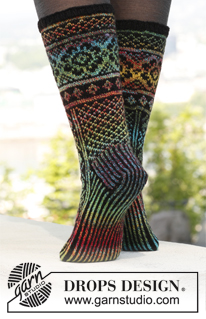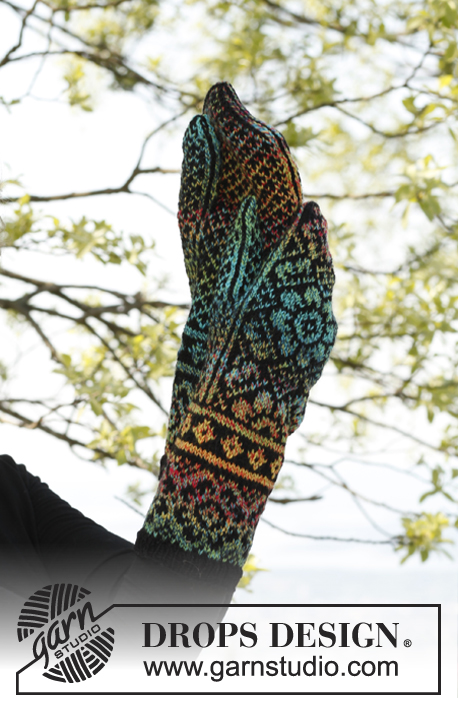Comments / Questions (79)
![]() Soile Snell wrote:
Soile Snell wrote:
Nyt en ymmärrä miten tuo a7 kuvio tehdään? Siis ennen kantapäätä kun toiset silmukat ovat odottamassa.
11.05.2025 - 22:54DROPS Design answered:
Hei, neulot tasona kantapään silmukoilla piirroksen A.7 mallineuletta. Eli neulot vuorotellen yhden silmukan mustalla langalla ja yhden silmukan karnevaalin värisellä langalla.
12.05.2025 - 17:00
![]() Agata wrote:
Agata wrote:
We're closing stitches around stitch n35 for both socks? Shouldn't we close stitches around stitch N1 for the left sock?
15.04.2025 - 20:52DROPS Design answered:
Witaj Agato, prawa i lewa skarpetka są identyczne, więc wszystkie operacje są wykonywane tak samo. Pozdrawiamy!
16.04.2025 - 08:05
![]() Rachel Alperstein wrote:
Rachel Alperstein wrote:
You can ignore my previous question. I realized I have decrease before and after Each A-4. Thanks anyway!
11.06.2024 - 00:36
![]() Rachel Alperstein wrote:
Rachel Alperstein wrote:
Hello, the math on the toe decrease is not adding up. If I have 66 stitches after the heel decrease, and then decrease 2 every other row for 7 rounds and then every row for 3 rounds, then I would end up with 46 stitches, but the pattern says I should end up with 26 stitches. Please clarify.
10.06.2024 - 23:25DROPS Design answered:
Dear Mrs Alperstein, you first decrease 4 sts a total of 7 times on every other round (the first decrease as explained + 6 more times) then decrease 4 sts a total of 3 times on every round, this means you will decrease 4x7 + 4x3 = 40 sts; there were 66 sts - 40 = 26 sts remain. Happy knitting!
11.06.2024 - 08:06
![]() Hanna Kylin wrote:
Hanna Kylin wrote:
The socks in the picture are beautiful, but the pattern is very hard to interpret. Information does not appear in the order needed, some information is missing (mainly regarding how to do the heel), and the size is very wrong. I'm a 37, knitted accordingly, and inside out in order to make sure the floaters would not render the sock to tight, and I could not get it on my foot. I had to unravel it all. I see that others have the same experience and aske for a revised pattern.
21.05.2024 - 18:35
![]() Idamarie wrote:
Idamarie wrote:
Hej. Jeg strikker 35-37 og jeg er kommet til mønster A3, hvor det ikke går op med 66 masker - jeg kan se i et andet spørgsmål at man skal strikke det 5 1/2 gang og så går det op - bliver der så ikke rod i mønsteret? vil der så ikke være en del af mønstret til sidst der ikke er færdigt?
25.07.2023 - 09:42DROPS Design answered:
Hei Idamarie Om du ser på diagram A.3, så er det to like "blomst" og når du har 66 masker får du bare strikket diagrammet 5,5 ganger. Om du tenker at diagrammet bare går over 6 masker ville du ha strikket A.3 11 ganger, resultatet blir det samme om du strikker A.3 slik du ser det med 12 masker 5,5 ganger. mvh DROPS Design
27.07.2023 - 14:36
![]() Maryanne Blackburn wrote:
Maryanne Blackburn wrote:
Hello I am trying to make you Iriah Dream 143-33 socks but I am unable to see the charts can you assist please thank you
25.06.2023 - 16:47DROPS Design answered:
Hi Maryanne, The charts are found at the bottom of the page. Happy knitting!
26.06.2023 - 06:52
![]() Carola Örnfjäll wrote:
Carola Örnfjäll wrote:
Tänkte sticka sockar Irish dream, 143-33, men färg 820 verkar inte finnas. Har den utgått el bytt nummer. Isf vad kan ni rekommenderar för ersättningsgarn. Mvh Carola
21.01.2023 - 14:48DROPS Design answered:
Hei Carola. Ja, farge 820 er utgått fra vårt sortiment. Anbefaler deg å ta en titt på alle våre farger i DROPS Fabel og velg den fargetonen du syns er penest. mvh DROPS Design
23.01.2023 - 11:52
![]() Åsa wrote:
Åsa wrote:
Hej! Mönster för A2 och A5 tycks ha försvunnit?
18.04.2022 - 20:34
![]() Eva wrote:
Eva wrote:
Quisiera comprar la la a carnaval y la negra para haceros Calcetines
12.03.2022 - 21:35DROPS Design answered:
Hola Eva, nosotros no vendemos las lanas desde esta página. Puedes contactar con tu tienda DROPS más cercana u otras tiendas DROPS con envío a España, que puedes encontrar en el siguiente link: https://www.garnstudio.com/findastore.php?id=23&cid=23 para consultar su disponibilidad de estas lanas. En principio este color se encuentra descontinuado.
13.03.2022 - 22:14
Irish Dream#irishdreamsocks |
|||||||||||||
 |
 |
||||||||||||
Knitted DROPS socks with pattern in "Fabel".
DROPS 143-33 |
|||||||||||||
|
PATTERN: Diagrams A-1 to A-7. All diagrams are worked in stockinette st. HEEL DECREASE: Row 1 (= RS): K until 9 sts remain, slip 1 st as if to K, K 1, psso, turn piece. Row 2 (= WS): P until 9 sts remain, slip 1 st as if to P, P 1, psso, turn piece. Row 3 (= RS): K until 8 sts remain, slip 1 st as if to K, K 1, psso, turn piece. Row 4 (= WS): P until 8 sts remain, slip 1 st as if to P, P 1, psso, turn piece. Continue dec like this with 1 st less before every dec until there are 15 sts on needle. -------------------------------------------------------- SOCK: Worked in the round on double pointed needles. Cast on 72 sts for all sizes on double pointed needles size 2.5 mm / US 1.5 with black. K 1 round, then work 6 rounds rib = K 1/P 1. Switch to double pointed needles size 3 mm / US 2.5. Then work diagram A-1 over all sts 1 time vertically, then work diagram A-2 1 time vertically. REMEMBER THE GAUGE! Continue with A-3 - AT THE SAME TIME on first round dec 6-0-0 sts evenly = 66-72-72 sts, and on last round dec 0-2-2 sts evenly = 66-70-70 sts. When A-3 has been worked 1 time vertically, continue as follows: A-4 (= 3 sts) A-5 (= 25-29-29 sts), A-4 (= 3 sts) and A-6 (= 35 sts) - dec as shown in diagram A-6. When A-5 and A-6 have been worked vertically, 62-66-66 sts remain on needle. Now slip the first 31-35-35 sts on a stitch holder (= sts over A-4 + A-5 + A-4) = 31 sts remain on needle for heel. Continue with A-7 over heel sts for 5-5½-6 cm / 2"-2¼"-2½", insert a marker, then work HEEL DEC – see explanation above! After heel dec, pick up 12-13-14 sts along each side of heel and slip the 31-35-35 sts from stitch holder back on needle = 70-76-78 sts. Continue the 31-35-35 sts on top of foot in pattern as before, work the other sts in A-7 (= under foot) - AT THE SAME TIME dec on each side of the 31-35-35 sts on top of foot as follows: K tog the 2 sts before the 31-35-35 sts on top of foot and K the 2 sts after the 31-35-35 sts on top of foot twisted tog, repeat dec every other round 5 more times = 58-64-66 sts. Continue pattern until piece measures 18-19-22 cm / 7"-7½"-8¾" from marker on heel (= approx. 4-5-5 cm / 1½"-2"-2" remain). Then work as follows: A-4 as before over the sts in each side and A-7 over the 25-29-29 sts on top of foot and the 27-29-31 sts under foot - AT THE SAME TIME dec for toes on each side of A-4 in each side as follows: Work until 2 sts remain before A-4, K 2 tog, work A-4, then K 2 twisted tog. Repeat dec every other round 3-6-6 more times and then every round 5-3-3 times = 22-24-26 sts remain on needle. On next round, with black K2 tog around = 11-12-13 sts. Cut the thread and pull it through the remaining sts, tighten tog and fasten. |
|||||||||||||
Diagram explanations |
|||||||||||||
|
|||||||||||||

|
|||||||||||||

|
|||||||||||||
Have you finished this pattern?Tag your pictures with #dropspattern #irishdreamsocks or submit them to the #dropsfan gallery. Do you need help with this pattern?You'll find 11 tutorial videos, a Comments/Questions area and more by visiting the pattern on garnstudio.com. © 1982-2025 DROPS Design A/S. We reserve all rights. This document, including all its sub-sections, has copyrights. Read more about what you can do with our patterns at the bottom of each pattern on our site. |
|||||||||||||


















































Post a comment to pattern DROPS 143-33
We would love to hear what you have to say about this pattern!
If you want to leave a question, please make sure you select the correct category in the form below, to speed up the answering process. Required fields are marked *.